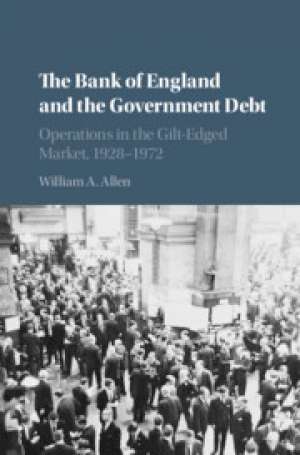25 July 2019
The Bank of England and the Government Debt:
Operations in the Gilt‑Edged Market, 1928‑1972
William A Allen
2019, Cambridge University Press,
ISBN 9781108605830
Reviewer: John Shepperd, previously Economist, Mullens & Co

The notion that “the past is a foreign country, they do things differently there” may apply whenever you look at the history of financial markets. But never more so, perhaps, than in the case of the Gilt-edged market prior to the wholesale transformation of Big Bang in 1986. Some of the key participants are still familiar – the Bank of England and the Treasury of course. But some are long forgotten. The Government Broker, a term which covered a firm (Mullens & Co.) and an individual (the Senior Partner of Mullens who was “the” Government Broker). And then the jobbers (stock exchange market-makers) and the Discount Houses. And the prominence of the Issue Department of the BoE, which underwrote the fixed-price tender issues of new stocks, and managed the secondary market by selling “taps” and supporting the market when necessary.
Bill Allen is especially well qualified to explore this market, having been at the BoE from 1972 to 2004. I had a brief glimpse of the last days of this world when I was the economist at Mullens & Co. in the few years prior to Big Bang. What Bill Allen has done is to microscopically examine the records of official involvement in the gilt market from 1928-1972, using the archives of the BoE and the Treasury as well as more accessible published material. Much of his study focusses on official price and dealing records, although some of the most revealing insights come from memos written between the key players – the BoE, the Treasury and the Government Broker.
What emerges from the detail is a market that through the 1950s and 1960s staggered from crisis to crisis. Not so much external shocks – devaluations, elections – but crises that came from the chronic inefficiency of the secondary market. The “authorities” were committed to keeping this secondary market on the floor of the Stock Exchange. The key problem was that the jobbers were chronically undercapitalised. Capital reserves were dependent on the personal wealth of the partners – and were always vulnerable to an aged partner retiring and taking his money with him.
The official view was that nobody would invest in gilts unless there were an efficient and liquid secondary market. So official action in the 1950s and 1960s was directed to that end. How did this that Holy Trinity of the BoE, the Treasury and the Government Broker keep the show in the road? By massive and often clandestine support for the jobbers. This took varies guises. Providing them with inside information about upcoming events that might hit market prices. Buying stock from them at above market prices. And, at times, by providing capital support to keep them in business. Major support operations in 1952, 1957, 1960, 1965 and 1967 to make sure the jobbers did not go under.
Who knew about these operations? “Debt management was conducted in great secrecy by about half a dozen people, assisted by the Government Broker, his deputy and his dealing partner”. Much of debate was oral, and “leaving of few written records was, at times at least, deliberate”. In particular the bail-out of the jobbers, using public funds, may not have even been disclosed to the Treasury, with Allen reporting he could find no written evidence that it was although he suspects that “one or two” Treasury officials may have been told “and were asked to keep it to themselves”. Why did this Heath Robinson system survive for so long? Perhaps because only small group of committed people controlled it. Crucially, perhaps, men (and they were, of course, all men) who were from the same social class, the same educational background, who would have moved in the same social circles.
Bill Allen’s history starts in 1928, when the Issue Department was expanded to give it the main role in the BoE’s operations in the secondary market. And it ends in 1972 when the new Competition and Credit Control regime meant the authorities were inclined to take a less interventionist role in the market. Perhaps, however, the key determinant of the end date is not the change in policy, but the emergence of two well capitalised and well run gilts jobbers Wedd Durlacher, and Akroyd and Smithers, which meant there was less need for official participation to maintain an orderly market.
This is a fascinating book for those with an interest in what now comes across as the often bizarre history of pre-Big Bang financial markets. When nods and winks determined market positioning, when insider trading was a part of the accepted way of doing things, and when you could rely on your friends to bail you out if necessary. At times the detail in the book, often with accounts of daily gilt prices changes through times of intense crisis, can be overwhelming. But the big picture emerges clearly from the details. A big picture which, from the modern perspective, can still generate a profound sense of amazement. Was the market for UK Government bonds really like that? Yes it was.
